Alexis I (1629 - 1676)
Alexis Mikhailovich Romanov was born in Moscow on 29 March 1629, the son of Tsar Mikhail I and Eudoxia Streshneva. When Alexis was five, his father appointed a well-born if penurious nobleman, Boris Morozov, as his tutor. Traditionally princes were given only an elementary education, but Morozov taught him about the technology of the West, introduced him to Latin, Greek and Polish and helped him build up a library. He was an excellent choice and unusually for princes growing up in the Kremlin, Alexis had a happy childhood. Morozov arranged that Alexis should be taught with twenty other boys and when he was nine he was joined by a boy four years older named Artemon Matveyev. As Mikhail I himself reflected later, Morozov - who spent thirteen years 'living constantly with us' - had almost become one of the family.
Alexis acceded to the throne at the age of sixteen after his father's death on 12 July 1645. On 18 August, his mother died, thus the teenager Alexis had lost both parents within five weeks. He went on pilgrimage to Zagorsk, then fasted and prayed to purify himself, and, on 28 September, wearing the blessed red, gold and white robes, the tsar processed to be crowned in the Dormition Cathedral. The new tsar looked the part and lived it too: tall, energetic and healthy, with a lustrous red beard, he enjoyed falconry and hunting. His personal papers reveal an intelligent, restless and sharp-tongued reformer. He wrote poems, made sketches and constantly wrote down ideas on every possible subject; he always sought foreign technology to improve his army and palaces.
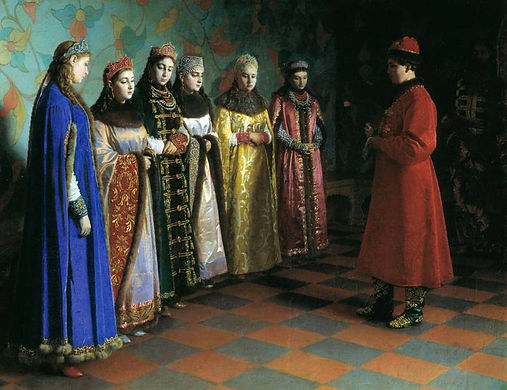
Tsar Alexis I chooses his bride by Gregory Sedov (1882);
the winner of the contest organised by Boris Morozov was his relative Maria Miloslavskaya

Maria Miloslavskaya (1625-1669),
daughter of Ilya Danilovich Miloslavsky and
Catherine Fedorovna Narbekova
Straight after the coronation, Alexis retired his father's chief minister Fedor Sheremetev, now aged sixty-nine, and promoted his tutor, Boris Morozov. In one of his first decisions Morozov organised a brideshow. On 4 February 1647, Alexis selected Efemia Vsevolozhskaya. The wedding was quickly scheduled for the 14th of February to avoid poisoning or maleficence but at a public ceremony the girl fainted as the crown was set on her head, sparking fears of witchcraft. Whether she had been poisoned or was just unlucky, Morozov, who had favoured another candidate, exploited her misfortune. She was given the fine linens prepared for her wedding as a parting present and exiled with her family. When the new brideshow was resumed, Morozov favoured the two daughters of his protege, Ilya Danilovich Miloslavsky. And they were ideal because, if the tsar married one sister, Morozov could marry the other. On 17 January 1648 he procured the marriage of the tsar with Maria Miloslavskaya, himself marrying her sister - Anna. The weddings brought much power to Morozov and especially Ilya Miloslavsky, who was made boyar and was one of the most powerful courtiers between the wedding in 1648 and his own death in 1668. Soon Morozov became the most hated man in Moscow, where the discontent reflected a concurrence of war, revolution and famine across Europe.

Boris Ivanovich Morozov (1590-1661),
a Russian statesman and boyar
during Tsar Alexis I's reign

At the Feast of Boyar Morozov by Konstantin Makovsky (1895)
Russians were strongly tied to tradition and feared they would lose their long cherished personal connection to the tsar. While the tsar remained ever pure in the eyes of the people, popular opinion held that his advisors exercised an evil influence over him. They resented Boris Morozov for usurping power from the divinely appointed Alexis I and for changing the established system. The Moscow uprising of 1648, sometimes known as the Salt Riot, started because of the government's replacement of different taxes with a universal salt tax for the purpose of replenishing the state treasury after the Time of Troubles. This drove up the price of salt, leading to violent riots in the streets of Moscow. On 11 June, Alexis I managed to convince the people to allow Morozov to be exiled to the Kirilo-Belozersky Monastery in Siberia. The tsar appointed a new boyar group led by Yakov Cherkasky and Nikita Romanov, who began distributing money and lands to the nobility and made a few concessions to the remaining rebels, including the postponement of collection of arrears on 12 June. The government's measures widened the split among the rebels, leading to the arrest and execution of many of the leaders of the uprising on 3 July. On 22 October, Morozov secretly returned to Moscow under the tsar's order and resumed his position as the head of the Russian government, relieving Nikita Romanov of the post. Thus, the immediate outcomes of the Salt Riot reversed themselves and the old order became solidified in an official legal code - Sobornoye Ulozhenye (1649). The code consolidated Russia's slaves and free peasants into a new serf class and pronounced class hereditary as unchangeable (see Russian serfdom). The new code prohibited travel between towns without an internal passport. Russian nobility agreed to serve in the army, but were granted the exclusive privilege of owning serfs.

Nikon, Nikita Minin (1605-1681),
Patriarch of Moscow, serving officially in 1652-1666
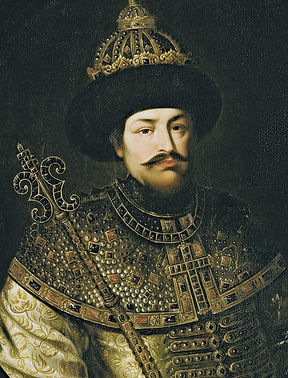
Tsar Alexis I of Russia in 1645-1676
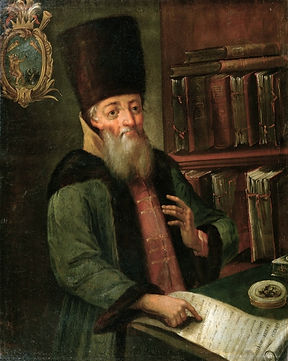
Afanasy Ordin-Nashchokin (1605-1680),
son of a poor official from Pskov;
first Russian Chancellor in 1667-1671
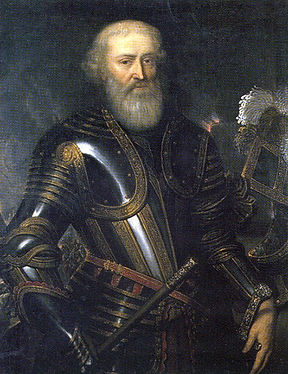
Artemon Sergeyevich Matveyev (1625-1682),
a Russian statesman, diplomat and reformer
In 1650, Alexis I faced two more rebellions in the cities of Pskov and Novgorod. He put down the Novgorod rebellion quickly, but was unable to subdue Pskov and was forced to promise the city amnesty in return for surrender. One man only had displayed equal tact and courage at Novgorod, Metropolitan Nikon, who in consequence became in 1651 the tsar's chief minister. On 1 August 1652 he was elected Patriarch of Moscow, however, Nikon knew that he was rather unpopular with the Russian nobility and declined the offer several times. He gave in after the tsar himself and the boyars fell on their knees, begging him to accept the post. He only yielded after imposing upon the whole assembly a solemn oath of obedience to him in everything concerning the dogmas and canons of the Orthodox Church. He preached that the Orthodox mission of the Russian tsar must be purified, ready for a crusade against the Catholic Poles and Islamic Tatars.
On 1 October 1653 the National Assembly met at Moscow to sanction the war against Poland and find the means of carrying it out and in April 1654 the army was blessed by Patriarch Nikon. On 18 May 1654, accompanied by Morozov and his father-in-law, Ilya Miloslavsky, Alexis I, just twenty-five years old, led his army out of Moscow towards Smolensk. The campaign of 1654 was an uninterrupted triumph and towns, including the important fortress of Smolensk, fell into the hands of the Russians. Russia not only recovered Smolensk but also occupied all of what is now eastern Ukraine, Belarus and even took the traditional Lithuanian capital Vilnius. In the summer of 1655, the sudden invasion by Charles X of Sweden for the moment swept the Polish state out of existence, in what became known as the Deluge. The Russians, unopposed, quickly appropriated nearly everything which was not already occupied by the Swedes and, when at last the Poles offered to negotiate, the grand duchy of Lithuania was the least of the demands of Alexis I. Fortunately for Poland, the tsar and the Swedish king now quarrelled over the apportionment of the spoils and at the end of May 1656 Alexis I, encouraged by Holy Emperor Ferdinand III and the other enemies of Sweden, declared war. In the meantime Poland had so far recovered herself as to become a more dangerous foe than Sweden and, as it was impossible to wage war with both simultaneously, Alexis I resolved to rid himself of the Swedes first, which he did by the Peace of Kardis on 2 July 1661, whereby Russia retroceded all her conquests.
Meanwhile, Nikon made it his mission to remove the church from secular authority and permanently separate the church from the state. He also sought to organize the church with a hierarchy similar to the state's - with the patriarch in complete control. The priest and the young autocrat openly clashed during a service. In the result, Alexis I ceased to consult him, half revering, half lothing the man. On 4 July 1658, Alexis I did not invite the patriarch to a banquet for the visiting Georgian king Teimurz I. Almost as a test of wills and, perhaps, hoping to dramatize his own importance, Nikon publicly stripped himself of his patriarchal vestments in the summer 1658 and went to live at the New Jerusalem Monastery, that he, himself, founded in the town of Istra. For many years the tsar and Nikon remained estranged and their conflict unresolved.
By the 1660s, Alexis I's wars with Poland and Sweden had put an increasing strain on the Russian economy - his government had begun minting copper coins in an attempt to increase government revenue, but this instead led to a devaluation of the ruble and a severe financial crisis. As a result, angry Moscow residents revolted in the 1662 Copper Riot, which was put down violently. Up to thousand men were hanged or drowned in the Moscow River. Several thousand people were arrested and later exiled after the brutal investigation. The Salt Riot shook the tsar, who suffered palpitations, nosebleeds and indigestion which his doctors treated with laxatives, opium and hellebore to slow the heart down.
In December 1666, Nikon was tried by a synod of church officials, known as the Great Moscow Synod. During the proceedings, Nikon staunchly defended his belief that the church's authority and power were and ought to be supreme. On 12 December the synod, pronounced him guilty of reviling the tsar and the Orthodox Church and of beating and torturing his dependents. His sentence was deprivation of all his sacredotal functions; henceforth he was to be known simply as the monk Nikon. The same day he was put into a sledge and sent as a prisoner to the far northern Ferapontov Monastery. Yet the very council which had deposed him confirmed all his reforms and anathematized all who should refuse to accept them. Nikon survived Alexis I with whom something of the old intimacy had been resumed in 1671. In 1681 Tsar Fedor III, on hearing that Nikon was dying, allowed him to return to Moscow and, under a partial pardon, take up residence in his former Moscow home, the New Jerusalem Monastery. Unfortunately at Yaroslavl on his way there, after crossing the Kotorosl River, he died in Tropino on 17 August 1681.
In the meantime, the Polish were handicapped by internal dissent and the outbreak of a civil war between the various noble factions. It was due to Afanasy Ordin-Nashchokin's abilities and his tenacity of purpose that Russia succeeded in concluding with Poland the advantageous Truce of Andrusovo on 11 February 1667. On his return to Russia he was created a boyar and entrusted with the direction of the Foreign Office, with the title of Guardian of the Great Tsarish Seal and Director of the Great Imperial Offices. He was, in fact, the first Russian chancellor. According to the truce, Polotsk and Polish Livonia were restored to Poland, but the more important Smolensk and Kiev remained in the hands of Russia together with the whole eastern bank of the Dnieper River.
The year of 1667 was undoubtedly one of triumph for Alexis I. Not only had he defeated the Polish enemies who had held Russia in check for two centuries, but he also showed who was in charge in the Orthodox Church. Indeed, he felt confident enough to impose higher tariffs on Western European import and export trade with Russia and made a move to intensify economic ties with Safavid Iran. This was potentially lucrative, as the Persians were a key source for raw silk that was in high demand at that time in Western Europe. Alexis I's atempts to reroute this trade away from the overland caravan route that ended at Turkish held Mediterranean ports did not succeed in the end because he was confronted with Stepan (Stenka) Razin rebellion in 1670-1671.
A long war with Poland in 1654-1667 and Sweden in 1656-1658 put heavy demands upon the people of Russia. Many peasants, hoping to escape the burdens, fled south and joined bands of Razin's marauding Cossacks. They were also joined by many others who were disaffected with the Russian government, including people of the lower classes, as well as representatives of non-Russian ethnic groups such as the Kalmyks, that were being oppressed at the time. Razin's first considerable exploit was to destroy the great naval convoy consisting of the treasury barges of the rich merchants of Moscow. Razin then sailed down the Volga, capturing the more important forts on his way and devastating the country. At the beginning of 1668, he defeated Yakov Bezobrazov, sent against him from Astrakhan, and in the spring embarked on a predatory expedition into Daghestan and Persia, which lasted for eighteen months.
On 24 June 1670 Razin reached Astrakhan, which occupied a strategically important location at the mouth of the Volga River on the shore of the Caspian Sea. He plundered the city despite its location on a strongly fortified island and the stone walls and brass cannons that surrounded the central citadel. After massacring all who opposed him and giving the rich bazaars of the city over to pillage, he converted Astrakhan into a Cossack republic, dividing the population into thousands, hundreds and tens, with their proper officers, all of whom were appointed by a general assembly and whose first act was to proclaim Stepan Razin their sovereign.
After a three-weeks carnival of blood and debauchery Razin quit Astrakhan with two hundred barges full of troops. His aim was to establish the Cossack republic along the whole Volga River as a preliminary step towards advancing against Moscow. Saratov and Samara were captured, but Simbirsk defied all efforts and after two bloody battles on the banks of the Svyaga River, Razin was routed by the army of Yuri Baryatinsky and fled down the Volga River, leaving the bulk of his followers to be extirpated by the victors. At Simbirsk Razin's prestige had been shattered. Even his own settlements at Saratov and Samara refused to open their gates to him and the Cossacks, hearing that the patriarch of Moscow had anathematized Razin, also declared against him.

Stepan Razin Sailing in the Caspian Sea by Vasily Surikov (1906)
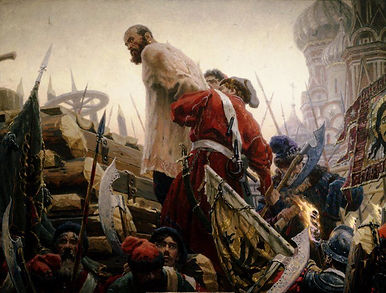
The Execution of Stepan Razin
In June 1671 Razin and his brother Frol were captured at Kagalnik fortress. They were given over to the tsar's officials in Moscow, where Stepan Razin was tortured then quartered alive at Lobnoye Mesto. However, the rebellion did not end with Razin's death. The rebels in Astrakhan held out until 26 November 1671, when Ivan Miloslavsky restored government control. The Cossacks lost some of their autonomy and the tsar bonded more closely with the upper class because both feared more rebellion.
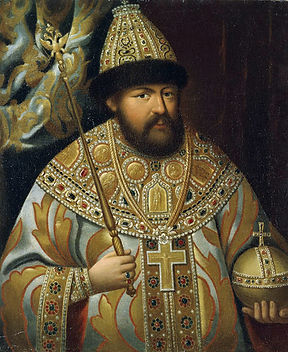
Tsar Alexis I of Russia in 1645-1676
On 3 March 1669, the forty-three years old Tsaritsa Maria gave birth to her thirteenth child, but the child and the mother died soon afterwards. The tsar's elder sons, Alexis Alexeyevich, the thirteen years old heir, and the frail Fedor Alexeyevich attended their mother's funeral. There were also two sickly toddlers, Semon and Ivan, but Semon died in June 1669. Then, on 17 January 1670, Alexis Alexeyevich died, leaving Fedor as the only heir. Thus a new marriage was imperative. In April 1670, the tsar narrowed his choice to Avdotia Belyaeva, who was backed by the tsar's eldest sister Irina, now aged forty-two, and Natalya Naryshkina, the ward of Alexis' childhood friend Artemon Matveyev. He had been educated with Alexis, had commanded his bodyguard and run his intelligence service. Now he was married to Mary Hamilton, daughter of a Scottish Catholic refugee from Protestant England, who was not hidden in a house, but was educated, very well dressed and free spoken. The eighteen years old Natalya Naryshkina, who had the dark wide eyes, a rounded sweet face, a high forehead, a beautiful figure and the limbs well proportioned', was the daughter of an obscure nobleman of Crimean Karaite descent.
At the wedding on 22 January 1671, Natalya was 'blooming with youth and beauty', but his eldest daughter was older than the bride. His six surviving daughters were kept in monastic splendour and boredom in the Terem Palace, but Alexis I had had them well educated. The most intelligent of them, the thirteen years old Sophia, especially hated the bride and the Naryshkins, who now threatened to displace the Miloslavskys as the leading family at the court. The wedding changed everything: the new tsaritsa's patron, Matveyev, took over the government, while the two Miloslavskys were despatched to govern provinces. On 30 May 1672, Natalya gave birth to a sturdy son, Peter.
On 29 January 1676, during a comedy in his new theatre, Alexis I, still only forty-seven, fell ill, his body swelling up alarmingly. The drugs were quickly made up by his doctors, but nothing could save the tsar from dying of renal and cardiac failure, on 8 February.
Alexis I's death was followed by an interlude in which the regents held the reins of power for most of the period 1676-1689. Court rivalries between the clans of Alexis I's first and second wives and their relatives hallmarked the period, with one particular ferocious moment of reckoning in May 1682. Throughout, it was the Miloslavskys that held the upper hand over the Naryshkins, but its efforts were always hindered by the absence of a credible male candidate for the throne.